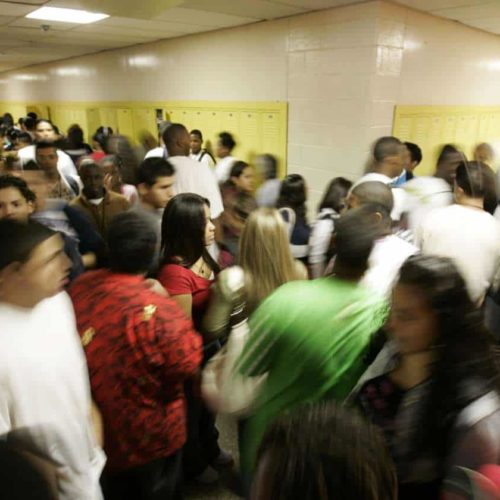Introduction
A newly released pool of federal data reveals that Kern County, California — whose schools were the subject of a recent Center for Public Integrity story — has exceptionally high rates of suspension and expulsions for minority students.
The new federal information dovetails with the findings of the Center’s investigation last December, which showed that Kern County, an oil and farm region in the Central Valley, is California’s expulsion capital. In 2010-2011, Kern’s schools had four times the state average for expulsions and more than seven times the last known national average in 2006. The raw number of students expelled in sparsely populated Kern was even greater than the number expelled in Los Angeles, which has nine times the student body.
Parents in Kern complained about high rates of removal for children and about the process for challenging decisions, and some black parents told the Center they felt schools were too quick to oust their children.
California state data analyzed by the Center demonstrated that the vast majority of Kern expulsions were not for “zero tolerance” violations that require expulsion, such as gun possession. The analysis showed that most of Kern’s expulsions were discretionary, and that the schools had unusually high rates of expulsion for defiance, disruption and obscenity. More than one in four expulsions statewide for obscenity or vulgarity took place in Kern.
Ethnic disparities
The state data, however, did not include a breakdown of the ethnicity of students. The new federal statistics do contain ethnic breakdowns, and confirm some parents’ concerns.
They show that in the Kern County city of Bakersfield, black students at Bakersfield High School were 15 percent of the school’s more than 2,700 students in 2009-2010, but represented 25 percent of all out-of-school suspensions and 29 percent of all expulsions. The statistics were submitted to the U.S. Department of Education’s Civil Rights Data Collection by the schools themselves.
The data also show that 30 percent of black males in that school were given more than one out-of-school suspension, compared to 12 percent of all males in the school. Suspensions can last up to five days at a time. Nearly a quarter of black males were expelled.
Strikingly, little more than 1 percent of black students in the school were expelled for “zero tolerance” violations that leave little or no room for administrators to keep students rather than removing them for a semester or a full year. The rest of the expulsions involved discretionary decisions by administrators.
Another large high school in Bakersfield — East Bakersfield High — also showed disproportionate discipline for black students in particular.
Twenty-two percent of the school’s black students were suspended more than once in 2009-2010, compared to 10 percent of the whole school population. That broke down, by gender, to almost 29 percent of the school’s black males getting more than one out-of-school suspension.
On top of that, about 21 percent of all black males students were expelled from the school, compared to 8 percent of all students.
East Bakersfield High School is about 81 percent Latino. The school, along with Bakersfield High, belongs to the Kern Union High School District, which is about 59 percent Latino, and is the single biggest high school district in California. The Center found that many of the Kern Union High School District’s two dozen-plus schools have a long-running pattern of expelling at least 100 students each annually.
High-level concern
The state and federal statistics for Kern County mirror discipline patterns nationwide that worry a growing number of educators and civil rights advocates.The numbers have also prompted action by the Obama Administration.
Critics of the high rates of suspension and expulsion fear that students are being removed so frequently from classrooms that the practice is making dropout rates worse among minorities and putting children on a path to trouble with the law.
On March 6, Secretary of Education Arnie Duncan unveiled the new Civil Rights Data Collection, which represents statistics turned in by schools serving about 85 percent of all American students.
The U.S. Department of Education’s analysis of numbers showed that while African Americans were 18 percent of the students in the total pool of data, they were 46 percent of students suspended more than once and 39 percent of those expelled.
“The undeniable truth,” Duncan also said, “is that the everyday educational experience for many students of color violates the principal of equity at the heart of the American promise.”
Duncan cautioned against attributing disproportionate discipline affecting an ethnic group to a single factor, whether that might be an assumption that minority students act out more, or that teachers and administrators harbor biases and are tougher on them.
Duncan said “it is our collective duty” to develop alternatives, including better teacher training and the adoption of counseling methods that prove effective at improving student behavior, improving student-teacher relationships and keeping kids in school.
Local procedures
In Kern, the expelled are often referred to county-run schools for troubled youth, including those accused of crimes. Although lists of the names of students are passed between the community and regular schools, students are not formally tracked to document whether they graduate or if they return to regular school.
Kern Union High School District administrators did not respond to requests for comment on the new federal statistics. Last year, Michael Zulfa, assistant superintendent of instruction, told the Center that the district didn’t believe its expulsion numbers were excessively disproportionate by ethnicity.
“We try to find that appropriate ground,” Zulfa said, “where student behavior really dictates what we’re doing in our disciplinary policies.”
Under pending legislation proposed in California in February, schools would be forced to enact special counseling plans to reduce suspensions if more than 25 percent of all students or an ethnic subgroup were affected. By 2018, the threshold number requiring schools to enact mandatory suspension-reduction plans would fall to 15 percent.
“While suspension and expulsion are sometimes necessary for student and campus safety, the overuse of such punishment for relatively minor offenses only makes behavior and achievement problems worse,” the proposal’s author, California Senate President pro Tem Darrell Steinberg, a Democrat of Sacramento, said in a statement.
“Schools need to attack the root problems,” he said, “by working with students and parents through programs to improve student success.”
Mindful of California’s public-school budget crisis, supporters of Steinberg’s bill say that effective counseling methods already exist that schools can turn to, and that they can benefit financially by recouping money that they now forfeit when students are suspended out of school. The bill has been referred to the state Senate’s education committee.
Read more in Education
Juvenile Justice
A judge, a teenage killer and a mother who forgives
Juvenile Justice
Supreme Court to review life without parole for juveniles
Nuances in arguments on constitutionality of prison until death


Join the conversation
Show Comments